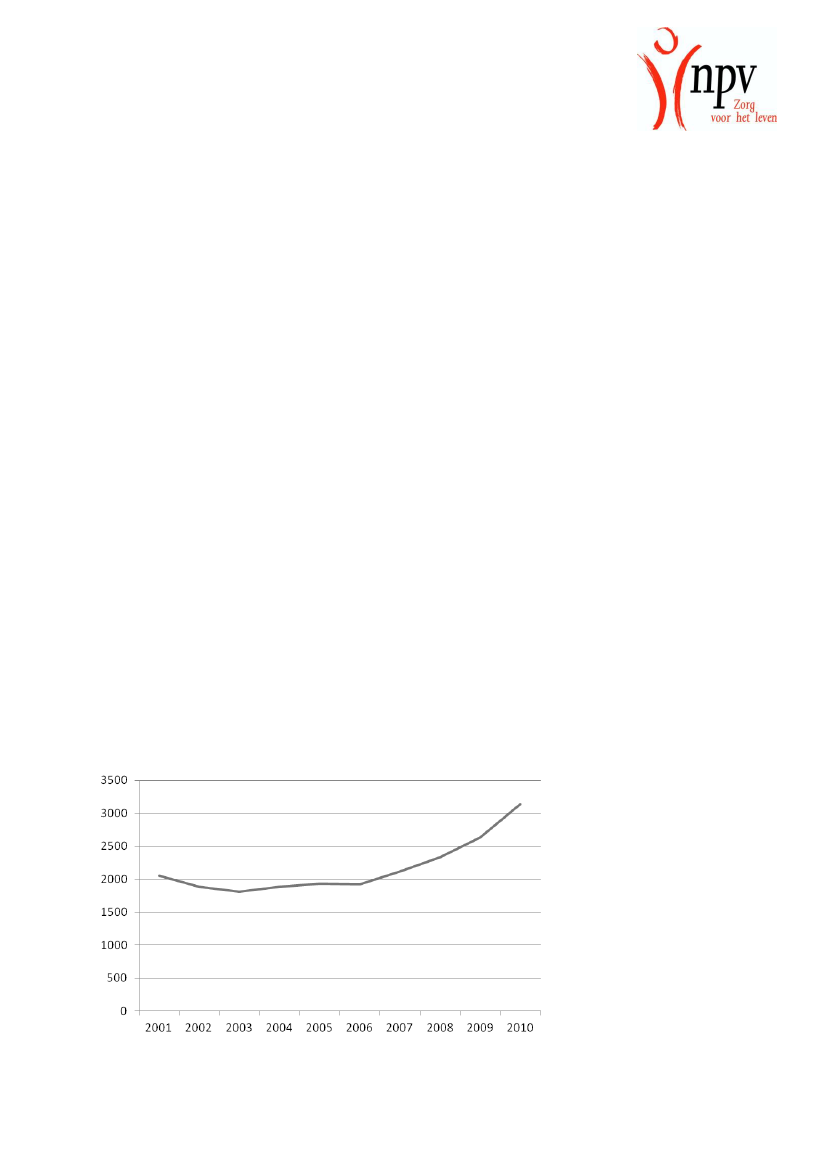Sundheds- og Forebyggelsesudvalget 2012-13, Udvalget vedrørende Det Etiske Råd 2012-13
SUU Alm.del Bilag 278, UER Alm.del Bilag 10
Offentligt




1. What is the Dutch Patients Association’s position on euthanasia?Our organization deNederlandse Patiëntenvereniging (NPV)(www.npvzorg.nl) is a Christian,pro-life organization with 63.000 members (in 2012). We reject the practice of euthanasia.We believe God is the Creator of life. The NPV is not affiliated with a particular church. Allchurches are represented, Protestant (reformed/evangelical), Roman Catholic, some Jewish,a single member without any church background.We have compassion for all the people who are dying as a result of a disease. We think it isimportant to invest in high quality care, assisted by doctors, nurses, relatives and specializedvolunteers. That care is not to terminate life, but to accompany a natural, not speeded up orslowed down, death as good as possible. That is dying with dignity.We want to tell you something about the Dutch practice and our organization, the NPV:Christian faith en moral (the basics of Dutch history) has led - contradictory - to theeuthanasia law. The Netherlands as a Protestant Christian nation in combination with anopen culture has led to a public discussion about dying. The sixties and seventies werecharacterized by negotiation and discussion about a lot of topics. The breaking through thetaboo of subjects assufferinganddeathwas inspired by a request of knowing the truth.People want to talk openly en honestly about death and euthanasia. In discussion, the choiceof the individual was a very important criterion. Christian norms and valuesoutsidepeoplewere replaced for normsinside people:they want to make their own choice and decisions.The Netherlands were the first country where a euthanasia law went into force. There is adifferent way people think and speak aboutsuffering.A little - but defining - elite started thediscussion. In 1973 a Dutch physician, miss Postma, gave her mother a mortal injection. Shewas condemned by court (Openbaar Ministerie (OM), the highest Dutch Court) for a weekimprisonment. This case has led to the start of the NVVE (Nederlandse Vereniging voor eenVrijwillig Levenseinde). This is the Dutch association for death out of free will. In 1984, thefirst bill concerning a euthanasia law was presented by ms. E. Wessel-Tuinstra (D66).The euthanasia law went into force 1 April 2002. From this time, there is an increasingnumber of reported cases of euthanasia to thetoetsingscommissies.This is a committee thatreviews the practice of euthanasia after the patient’s death.Line Chart reported cases in the Netherlands
NPVKerkewijk 115Postbus 1783900 AD Veenendaal
Telefoon:Fax:E-mail:Website:
1
Aantal euthanasiemeldingen in Nederland (bron: jaarverslagen Rte)199819992000200120022003200420052006200720082009201020113492.2162.1232.0541.8821.8151.8861.9331.9232.1202.3312.6363.1363.695
→ increase of 19% compared to 2009→ increase of 18% compared to 2010
At the moment 2.7% of all deaths in the Netherlands is caused by euthanasia which isreported at the committees.There are a lot of indistinct cases. We think a lot of physicians are afraid of the condemnationof the Openbaar Ministerie. Or maybe there is an increase of ‘terminale sedatie’, a way ofsedating people to make people die. That is a wrongful use of sedation, because the rightway is to use sedatives to diminish pain when people are dying, not to make people die. TheNPV called this ‘het grijze gebied’, the grey area. We firmly request an inquiry to clarify thiscases.
2. What is the Dutch Patients Association’s position on the Levenseinde kliniek ormobile service Life Unit?It is an absurd idea!-There is no relation between doctor and patient.-We wonder if these ‘mobile doctors’ are truly focused on the patient as a whole. What infact is the real question or what is the question below the question to die? You never cananalyze this in a few days!-There is not enough time to explore alternatives. We know from research that 10% of theeuthanasia requests are withdrawn in case of qualitative care. The clinic has no interest inpeople who change their minds and withdraw a request.-Hardly any health-insurance company in the Netherlands will pay for this ‘living-end-clinic’at this moment. They possibly fear for their image…This development is contradictive to the development of palliative care in the Netherlands.Before the creation of ‘mobile euthanasia teams’ we should have questioned ourselves: Howwell-developed is palliative care in the Netherlands? What is the percentage of terminally illpatients (roughly) who have access to palliative care? How much effort is taken by thegovernment to increase the number of palliative care facilities and to improve the specifictraining of medical professionals?There is an increasing attention for palliative care since 1990. Good research after thepossibilities of palliative care has never been done, but according to the ‘common sense’theory in the Netherlands there is a decreasing demand for euthanasia during good palliativecare. The government is stimulating palliative care and both people pro and contraeuthanasia are convinced that palliative care is really necessary.NPVKerkewijk 115Postbus 1783900 AD VeenendaalTelefoon:Fax:E-mail:Website:(0318) 54 78 88(0318) 54 78 99[email protected]www.npvzorg.nl
2
The character of euthanasia requests has slightly changed in the last thirty years,researchers of the NIVEL (Nederlands instituut voor onderzoek van de gezondheidszorg)presented in January 2012. In the seventies of the last century the most important reason foreuthanasia was pain. Nowadays loss of dignity and significance are also important reasonsfor a request of euthanasia.3. What is the Dutch Patients Association’s position on the citizens' initiative called Outof Free Will?We think this initiative is a clear expression of the fact the Netherlands are on a so-called‘slippery slope’:-Look at the numbers (see before): annual increase of euthanasia cases in relation todeclining mortality rates of the population in the Netherlands.-Euthanasia is practiced to elderly, dementia people, when they are no longer mentallycompetent.-Psychiatric patients can also call on the euthanasia law.In the Netherlands the discussion about ‘completed life’ was started in 2010. According tothis citizens’ initiative that was signed by 116,000 people, it should be possible for elderlypeople who are 70+ (but not ill!) to ask a ‘councelor’ to die. They ask for legalization by law. 8March 2012 the government has discussed this initiative, but at the moment there is notenough consensus about: How many people want this? What is the difference between thispopulation and the population of sick elderly people? How do we organize this? But also: isthis the right solution for elderly people? It is a question to our complete society.The NPV considers: The question is not: ‘How can we help people to die?’ But the questionshould be: ‘How can we help people to live?’In a completely secularized society, it is not amazing that questions rise about dying.4. When/How did the association create the living will declaration (the NPV-Levenswensverklaring)? How many have been distributed so far?The NPV has a ‘declaration of intent’ (de NPV-Levenswensverklaring) in which people canindicate how they want to be taken care of in their final stage of life. TheNPV-Levenswensverklaringis a declaration of somebody’s last will. People can explain whichmedical and nursing care they would like to receive in the final period of their lives when theyare incapable of pronouncing thus.Subjects that are mentioned in this declaration are:I want optimal medical cure and care, with the intention of healing.When healing is not possible, I want optimal care and concentration on welfare and reliefof suffering.I do not want others to judge about my ‘quality of life’ and I want treatments which areproportional (with the purpose to ameliorate my situation).Euthanasia is no option to alleviate my suffering.When I am dying, I do not want to receive treatments to lengthen my life.The physician has to communicate openly and honestly with my relatives orrepresentative.At the moment (December 2012) 6,487 declarations have been provided.NPVKerkewijk 115Postbus 1783900 AD VeenendaalTelefoon:Fax:E-mail:Website:(0318) 54 78 88(0318) 54 78 99[email protected]www.npvzorg.nl
3
5. Has the association organized other interventions to prevent euthanasia?Most people mention unbearable pain and suffering (seen by relatives) as a reason foreuthanasia. However, a lot of people do not know enough about the increased opportunitiesin pain control of the last decennia.The opinion of the Dutch anesthesiologist Ben Crul, a pioneer in the field of painmanagement and palliative care, is that euthanasia is unnecessary for most people with aterminal illness, with the current progress of pain management and palliative care. This viewis expressed by many doctors in the Netherlands. Ben Crul is a respected emeritus professorof pain management to the Radboud University in Nijmegen, who has dedicated his life tothe improvement of palliative care.It is necessary to invest in palliative care. Even health-care minister Els Borst (she wasresponsible for the introduction of the euthanasia law) admitted that ‘the law was introducedtoo quickly’ (http://vorige.nrc.nl/article2424976.ece).6. Does the association have polls on citizens’ opinion on euthanasia?In 2011, the KOPPEL-research was published:- 75% of the Dutch people knows the definition of euthanasia- 95% knows there is an euthanasia law- 20% knows what palliative sedation isThere is indistinctness about the concept of ‘unbearable suffering’:- 5% of the Dutch citizens is opposed to euthanasia- 7% of the doctors is opposed to euthanasia- 14% of the nurses is opposed to euthanasiaThe NVVE has also published a research, but one wonders whether this is independent.Sjoerd Notting, former lecturer at the Amsterdam University, thinks the results are not reliable(http://napnieuws.nl/2010/02/05/euthanasieonderzoek-onbetrouwbaar/).7. The annual report of thetoetsingscommissiessays the number of euthanasia casesreported to one of five special committees was 3,695 in 2011. Does the associationbelieve this number is high? Why?It is 2.7% of the Dutch death cases.The number is growing. In 2010 there were 469 cases that were not judged in time. In 2011this concerned even more cases (the number was not exactly mentioned in the report). Thewaiting time for review is unacceptably long, but the intention is that all cases will be judged.Therefore doctors have to wait for months before their case will be judged. The question iswhat will happen in future, when we know that there will be an increasing demand foreuthanasia, also stimulated bij the End of Life Clinic/mobile teams.
NPVKerkewijk 115Postbus 1783900 AD Veenendaal
Telefoon:Fax:E-mail:Website:
4




